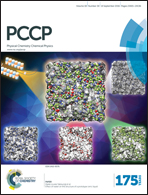The transport properties of silicon and carbon nanotubes at the atomic scale: a first-principles study†
Abstract
Nanotubes are one of the most promising functional materials in nanotechnology. Silicon nanotubes (SiNTs) have been experimentally validated; they are unique puckered nanotubular structures unlike carbon nanotubes (CNTs). Although the electronic and optical properties of SiNTs have been previously studied, their structure-related capability for electron transport has not been investigated. Here we report a comparative study of the intrinsic electronic and transport properties of four pairs of SiNTs and CNTs (one armchair nanotubes (3,3) and three zigzag nanotubes (5,0), (6,0) and (7,0)) using density functional theory (DFT) combined with the nonequilibrium Green's function (NEGF) method. All our investigated systems of SiNTs and CNTs are conductors. Both the armchair SiNTs and CNTs possess superior electron transport performance to their zigzag counterparts. Compared with CNTs, SiNTs have more advantages in the high bias voltage region. Especially, Si(3,3) possesses around double the potential charge capacity of C(3,3) under the bias voltage of 2.0 V. In particular, the CNT(6,0) exhibits distinct negative differential resistance (NDR) behavior and the peak–valley ratio (PVR) for C(6,0) is about 1.2.


 Please wait while we load your content...
Please wait while we load your content...